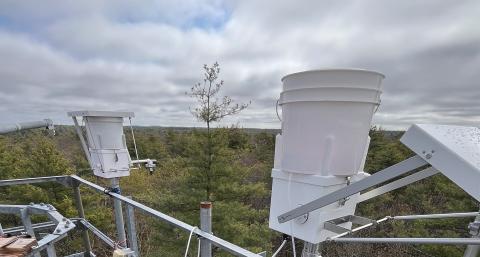This research was published in the INSPIRED: A Publication of the New Hampshire Agricultural Experiment Station (Spring 2024)
Researchers: D. S. Murray, M. D. Shattuck, W. H. McDowell & A. S. Wymore
New Hampshire and northern New England experienced significant land cover changes from forest to farmland and back again over the past century, and surrounding ecosystems have served as early indicators of environmental sensitivity to the impacts of these land cover changes. For example, acid rain was first identified in North America at New Hampshire’s Hubbard Brook Experimental Forest. As lands once used for agriculture have reverted to second-growth forests, they play a crucial role in the nitrogen cycle by absorbing atmospheric nitrogen deposits. However, as the northeastern United States grapples with elevated levels of nitrogen largely from food imports and atmospheric deposition, the ecological consequences are becoming more apparent, including alterations to forest nitrogen cycles and eutrophication in coastal waters.
Nitrogen Deposition
Nitrogen deposition not only influences plant growth and carbon sequestration but also affects the acidification of surface waters and the overall biodiversity within forest ecosystems. Despite efforts to manage nitrogen pollution, the region still faces the challenges of balancing agricultural productivity and energy demands with the need to protect ecosystem health and environmental integrity. This backdrop sets the stage for understanding the nuanced shifts in nitrogen deposition documented in recent studies and emphasizes the need for regional insights into these changes and their broader ecological impacts.
Methodology
This study leveraged 17 years of data, making it one of the longest-running studies of organic nitrogen precipitation in the world. Data were gathered from a wet deposition collector located at UNH’s Thompson Farm in Durham, NH, situated within New Hampshire’s Lamprey River watershed (Fig. 1).
The timespan of this study offers insight into how the various forms of nitrogen deposited by rain and snow have changed over time and how nitrogen levels and types are connected to precipitation and human impacts on the environment, including climate change.
While national trends indicate a decrease in inorganic forms of nitrate deposited by precipitation, regionally there has been an uptick in organic nitrogen levels. These shifts can be tied back to both human activity and a changing climate.
Key Findings
- Total dissolved nitrogen in precipitation has decreased, with a notable reduction in ammonium and nitrate and an increase in dissolved organic nitrogen.
- Nitrate is found in higher concentrations in snow, whereas rain is more enriched with ammonium.
- Warming winters and shifting seasonality could alter the chemistry of the precipitation, impacting regional biogeochemical cycles.
About the Co-author

Adam Wymore, Associate Professor of Natural Resources and the Environment
Contact information: Adam.Wymore@unh.edu, FindScholars profile

The study focused on three forms of nitrogen: nitrate, ammonium and dissolved organic nitrogen. It then looked at the relationship between these forms of nitrogen and how they changed seasonally and with the type of precipitation deposited, whether it was falling as rain or snow.
Results and Impacts
The data indicate that total dissolved nitrogen from wet deposition is declining (Fig. 2). However, the type of nitrogen present is changing, with both ammonium and nitrate decreasing and organic nitrogen increasing. And as organic nitrogen becomes a larger part of the nitrogen mix, the implications for ecosystems could be significant. For example, organic nitrogen often needs to be converted by soil microbes into forms that plants can use, which can slow plant growth, especially in ecosystems with more balanced nitrogen forms. This process can affect the timing of nutrient availability in surface water and the overall nutrient cycle.

Fig. 1. Land-use map of the Lamprey River watershed highlighting wet deposition nitrogen collection sites and their relationship to agricultural, forested, and developed land areas.
In water bodies, increased organic nitrogen can contribute to issues like harmful algal blooms, which degrade water quality by consuming oxygen and releasing toxins, thus affecting aquatic life and making the water unsafe for drinking and recreation. Understanding these shifts is crucial as they play into the larger puzzle of ecosystem health, influencing everything from the diversity of plant life to the integrity of aquatic habitats.
The type of precipitation also influences the nitrogen mix. Snow seems to have more nitrate compared to rain, which carries more ammonium. This is due to differences in the surface area between snow and rain and their ability to scavenge particles in the atmosphere. But as the climate changes and winters become warmer, it is possible to see more rain and less snow, implying more of nitrogen coming down could be in the form of ammonium-rich rain (Fig. 2).
A shift toward more ammonium-rich rain due to warmer winters has unique implications. For one, ammonium can be directly used by plants, potentially altering growth patterns and competitive balances within plant communities. However, if the ecosystem’s capacity to utilize this ammonium is exceeded, it can lead to leaching into waterways, contributing to eutrophication—a process where excess nutrients foster overgrowth of algae that depletes oxygen and harms aquatic life. This change in nutrient dynamics can ripple through the food web, affecting not just the local watershed but also the coastal areas that are connected to it, as excess nutrients are carried downstream, potentially leading to hypoxic zones where aquatic life struggles to survive.

Fig. 2. Frequency (%) of deposition samples in a given calendar year where NO3 − (nitrate) concentrations exceeded NH4 + (in brown), and where concentrations of NH4 + (ammonia) exceeded NO3 − (in blue) within the Lamprey River Hydrological Observatory. Note: The shaded region in panel represents the range of years with significant changepoints. The measurement mgL-1 is one milligram (dissolved) per one liter of water.
Implications for the Future
This study shows how even the invisible elements like nitrogen in precipitation are changing. Understanding these patterns is crucial for predicting and managing the health of ecosystems, like that of New Hampshire’s Lamprey River watershed. This knowledge can help communities and policymakers make more informed decisions when preparing for potential future environmental challenges.
This material is based on work supported by the NH Agricultural Experiment Station through joint funding from the USDA National Institute of Food and Agriculture (under Hatch award number 1022291) and the state of New Hampshire. Additional support came from the U.S. Environmental Protection Agency, the New Hampshire Water Resources Research Center, the USDA Sustainable Agriculture Research and Education (SARE) program, the national Science Foundation Experimental Program to Stimulate Competitive (EPSCoR) program and the NASA Future Investigators in NASA Earth and Space Science and Technology Program.

